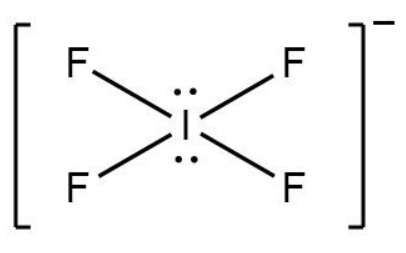
Steric number of the central atom in $ IF_4^ - $ is $ 6 $ . If true, enter $ 1 $ , else enter $ 0 $.
Answer
497.7k+ views
Hint: The compound which is mentioned in the question is an interhalogen compound. Its chemical name is iodine tetra-fluoride. Its existing form has already been given in the question. To find its steric number, we have to know its structure first. After that only we can find its steric number. The complete detailed solution is given in the below section.
Complete answer:
We can draw its structure by using VSEPR (valence shell electron repulsion theory) theory. The structure of $ IF_4^ - $ is shown below.

Now the formula to find its steric number is = Number of lone pairs + Number of bonded atoms.
As there are two lone pairs and four bonded atoms, so the steric number $ = 2 + 4 = 6 $ .
Therefore it is true that its steric number is $ 6 $ . The shape of this molecule is square planar and the hybridization of this molecule is $ s{p^3}{d^2} $ . We can find it through the VSEPR theory. As from its hybridization we can clearly see that one s-orbital, three p-orbital, and two d-orbital are mixed to form six hybrid orbitals.
Note:
Iodine forms many inter-halogen compounds such as iodine trifluoride, iodine penta-fluoride, etc. The chemical formula of iodine trifluoride is $ I{F_3} $ and the chemical formula of iodine penta-fluoride is $ I{F_5} $ . The shape of iodine trifluoride is T-shaped based on the VSEPR theory. It contains five electron pairs and out of them two are lone pairs. It is formed by the reaction of fluorine and iodine.
Complete answer:
We can draw its structure by using VSEPR (valence shell electron repulsion theory) theory. The structure of $ IF_4^ - $ is shown below.

Now the formula to find its steric number is = Number of lone pairs + Number of bonded atoms.
As there are two lone pairs and four bonded atoms, so the steric number $ = 2 + 4 = 6 $ .
Therefore it is true that its steric number is $ 6 $ . The shape of this molecule is square planar and the hybridization of this molecule is $ s{p^3}{d^2} $ . We can find it through the VSEPR theory. As from its hybridization we can clearly see that one s-orbital, three p-orbital, and two d-orbital are mixed to form six hybrid orbitals.
Note:
Iodine forms many inter-halogen compounds such as iodine trifluoride, iodine penta-fluoride, etc. The chemical formula of iodine trifluoride is $ I{F_3} $ and the chemical formula of iodine penta-fluoride is $ I{F_5} $ . The shape of iodine trifluoride is T-shaped based on the VSEPR theory. It contains five electron pairs and out of them two are lone pairs. It is formed by the reaction of fluorine and iodine.
Recently Updated Pages
Why are manures considered better than fertilizers class 11 biology CBSE

Find the coordinates of the midpoint of the line segment class 11 maths CBSE

Distinguish between static friction limiting friction class 11 physics CBSE

The Chairman of the constituent Assembly was A Jawaharlal class 11 social science CBSE

The first National Commission on Labour NCL submitted class 11 social science CBSE

Number of all subshell of n + l 7 is A 4 B 5 C 6 D class 11 chemistry CBSE

Trending doubts
10 examples of friction in our daily life

One Metric ton is equal to kg A 10000 B 1000 C 100 class 11 physics CBSE

Difference Between Prokaryotic Cells and Eukaryotic Cells

1 Quintal is equal to a 110 kg b 10 kg c 100kg d 1000 class 11 physics CBSE

State the laws of reflection of light

Explain zero factorial class 11 maths CBSE




